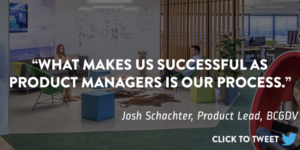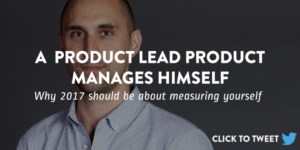Why this BCG Digital Ventures leader is product-managing himself
Josh Schachter is a product leader at BCG Digital Ventures (BCGDV). He has spent the last 10 years building digital products for enterprises, corporate startups, and his own ventures.
Recently at a BCG leadership event, I learned about an exercise: Developing and maintaining a personal KPI dashboard. What struck me was that in order for people to stick with their personal development, two things needed to exist:
- The ability to measure against those goals, and
- Having a sense of accountability towards reaching those goals.
It wasn’t so different from the discipline of product management, and reminded me of an experiment I’d done toward the end of 2016. Rolling off an intense project, I had felt an itch to reflect on my areas for development before my next venture at BCG Digital Ventures. So, I asked a newly onboarded product manager to help me conduct an informal and anonymous personal feedback review from my dozen or so teammates.
Over a series of interviews he asked two questions:
- What is the product (i.e. myself) doing well in the venture?
- In what areas could the product improve?
At the end of the review, there were no groundbreaking insights. The one area my teammates felt uncertain about was the transparency of the overall product picture—giving them a vantage of the forest above the trees. As a result, we increased our communication and painting of a holistic picture across all team tributaries.
But if 2016 was the year of introspection, 2017 is all about measurement and management. This is where thought becomes action. My New Year’s resolution is to maintain a personal KPI dashboard, in the hopes that it might even sharpen my professional acuity as a PM.
My 2017 dashboard goals are bucketed into three groups: “Work”, “Interpersonal”, and “Health & Wellness.” We’ll cover the first two.
KPI: Number of activities delegated
Product managers are privileged to sit smack in the middle of all the action! The fundamental role of the PM is often less the role of a doer, more the role of facilitator. At the beginning of my career, and even still today, I’ve felt a strong pride in task completion.
But the reality is that often less is more. Taking a divide and conquer approach works. The sharing and delegation of responsibilities creates efficiencies, broadens perspectives, and ultimately can be a much more effective way to drive a team forward, the pinnacle goal of any PM.
KPI: Did I share the ‘Why?’
PMs have a unique vantage. Because we help define the business goals and evaluate the needs of the customer, we inherently understand the reason our product exists. We also manage its roadmap. It’s (usually) clear to us how all the moving pieces will fit together, and what the value is in each component. And it’s imperative that we share this big picture thinking.
Sometimes, it’s so obvious to us that we neglect whether everyone else is also on board—which can create team misalignment, frustration, and reduce morale. An added layer at BCGDV is to make sure that our partner clients also share our vision and rationale.
There are several tactics that can help create and maintain this mutual understanding, like adding a “so that…” epilogue to user stories or creating executive summaries for each new product feature (e.g. Amazon.com-style).
This year my goal is to reinforce this habit by exiting every team conversation by asking myself “Did I share the ‘Why’?” I’m hoping that beating this simple question into my own mind will help me build the right habit.
As for the actual measurement of this KPI, I considered keeping a tally of all the times I tackled this goal each week. But in wanting to actually stick with this habit, I’ve thought it best to reduce as many frictions of its measurement as possible. Each week I simply rate myself as having been “Good,” “Very Good,” or “Needs Improvement.”

KPI: Active listening
Plain and simple: I need to do a better job listening, in the literal sense of the word. This is nothing new. My mother has told me this for a long time (the irony, of course, being that I never listened every time she told me). My mind drifts, and often in a professional setting begins thinking about what I’m going to say next.
My hunch is that I’m not alone.
This flaw can be fatal as a product manager. Just think about how many book recommendations you’ve seen come across on Amazon.com with some variation of the title “Listen to your customers.”
While that mode of listening may be more figurative, the reality is that within his or her team environment, a PM should aim to listen more than speak. Staying truly present is the only way to gather deeper insights from others, make collaborative decisions, and win the allegiance of your constituents. If anyone knows of any effective listening techniques, I’d love to hear them (pun partially intended). My hope is that by reinforcing this goal each week in my dashboard, it will help me become more purposeful in my weekly interactions.
Like “Sharing the ‘Why’”, I’m evaluating this KPI qualitatively rather than through a hard count.
KPI: Expressions of gratitude
At BCGDV, everyone works hard. Admirably hard. And in such a vigorous and rigorous environment, this is something of which it can be easy to lose sight.
In a course as a senior in college, I read a book called the One Minute Manager by Ken Blanchard. If you haven’t yet read it, you should (it’s only sold 15 million copies). In it Blanchard forms the concept of “one minute praise,” effectively catching somebody doing something right, and giving them praise. It’s “one minute” because it happens almost immediately from when the action occurred, and the praise itself can take short form. This simple practice, he proffers, incites motivation, general feelings of happiness, and reinforces positive behavior.
My goal for this year is to do this: Both personally and professionally, to express appreciation, gratitude, and praise to those closest to me.
During a client presentation in Denmark last week, I noticed that a colleague PM had offered a nice response to a question posed by the client’s management team. I made a mental note to give him some praise for that. At lunch immediately after the presentation, I shared the compliment. The only problem is that, while I remembered I wanted to compliment him for something specific, I couldn’t at all remember what it was he had said that warranted the compliment!
So, the whole free-flowing praise thing is still a bit of a learning curve. Likely, it will only become fully-honed once I’ve also mastered active listening as well.
Reflecting on this approach to my 2017 resolutions, I can admit that it would have been much more convenient to just make a wish at the stroke of midnight—to set it and forget it.
But so much of what makes us successful as product managers is our process: to identify needs, set goals, measure, and manage. Why not, then, apply that same modality to our own personal growth and development? It adds the same type of structure and benchmarking through which so many of our products have prospered. And by reinforcing that process-driven orientation in our personal lives, we may even improve that same orientation in us professionally.
One month in and I’m still going strong! I can’t claim to be a changed man, yet, but I’m happy to take baby steps. I look forward to sharing the journey along that path in 2017. (Oh, and as a PM, I also think there’s a commercial product lying somewhere inside the concept of a personal KPI dashboard.)



